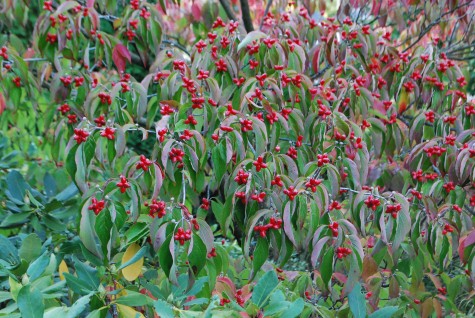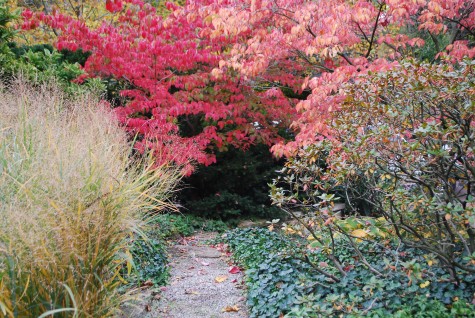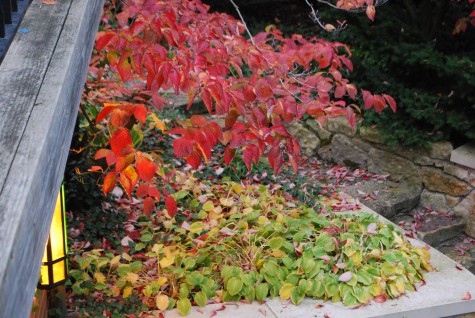 From the Missouri Botanical Garden website, read the following about the kousa dogwood. “Cornus kousa, commonly called Kousa dogwood, is a small, deciduous flowering tree or multi-stemmed shrub that typically grows 15-30’ tall, with a vase-shaped habit in the early years but eventually maturing to a more rounded form. Bloom occurs in late spring. The showy parts of the Kousa dogwood “flower” (3-5” across) are the four narrowly pointed petal-like white bracts which surround the center cluster of insignificant, yellowish-green, true flowers. Flowers are followed by berry-like fruits (to 1” diameter) which mature to a pinkish red in summer and persist into fall. Fruits are technically edible, but are usually left for the birds. Oval, pointed leaves (to 4” long) are dark green, but usually turns attractive shades of reddish-purple to scarlet in autumn. Mottled, exfoliating, tan and gray bark on mature trees is attractive in winter.
From the Missouri Botanical Garden website, read the following about the kousa dogwood. “Cornus kousa, commonly called Kousa dogwood, is a small, deciduous flowering tree or multi-stemmed shrub that typically grows 15-30’ tall, with a vase-shaped habit in the early years but eventually maturing to a more rounded form. Bloom occurs in late spring. The showy parts of the Kousa dogwood “flower” (3-5” across) are the four narrowly pointed petal-like white bracts which surround the center cluster of insignificant, yellowish-green, true flowers. Flowers are followed by berry-like fruits (to 1” diameter) which mature to a pinkish red in summer and persist into fall. Fruits are technically edible, but are usually left for the birds. Oval, pointed leaves (to 4” long) are dark green, but usually turns attractive shades of reddish-purple to scarlet in autumn. Mottled, exfoliating, tan and gray bark on mature trees is attractive in winter.
 This matter of fact description does not begin to address the beauty of a kousa dogwood in full and glorious bloom. I doubt I have ever written about them in the 10 years I have been publishing my garden design journal. Primarily as I have never ever seen them so spectacular in flower as they are right now. The kousa dogwood is native to Japan, Korea, China, and Taiwan. They are rated as hardy and thriving in zone 5 to 8, but my experience suggests they can act a little hostile towards our baking summers, and heavy clay based soil. They seem to favor thin compost rich soil on the acid side that drains in a twinkling of an eye. I do find they perform better than American dogwood (cornus florida) in general.
This matter of fact description does not begin to address the beauty of a kousa dogwood in full and glorious bloom. I doubt I have ever written about them in the 10 years I have been publishing my garden design journal. Primarily as I have never ever seen them so spectacular in flower as they are right now. The kousa dogwood is native to Japan, Korea, China, and Taiwan. They are rated as hardy and thriving in zone 5 to 8, but my experience suggests they can act a little hostile towards our baking summers, and heavy clay based soil. They seem to favor thin compost rich soil on the acid side that drains in a twinkling of an eye. I do find they perform better than American dogwood (cornus florida) in general.
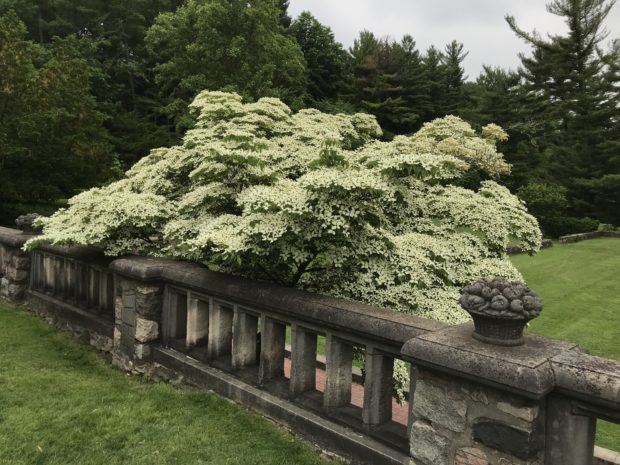 My theory seems to have some support. This has been the rainiest and coolest spring I can ever remember. We have had many more rainy than dry days. It was 48 degrees this morning, and barely 60 degrees this afternoon. The ground is completely drenched. I make an effort to stay out of the garden, even if it means the foot tall weeds are getting closer to 2 feet tall. The grass is squishy. For the Kousas to put on such a rare show of extravagant bloom says there is definitely something in the air that they like.
My theory seems to have some support. This has been the rainiest and coolest spring I can ever remember. We have had many more rainy than dry days. It was 48 degrees this morning, and barely 60 degrees this afternoon. The ground is completely drenched. I make an effort to stay out of the garden, even if it means the foot tall weeds are getting closer to 2 feet tall. The grass is squishy. For the Kousas to put on such a rare show of extravagant bloom says there is definitely something in the air that they like.
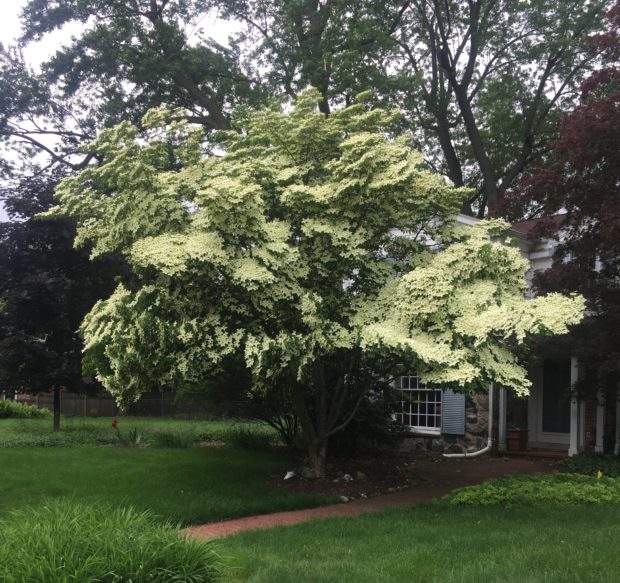 The actual flowers are small and insignificant. All of the show comes from the four stiff bright white bracts that surround the flower. In a stellar year, those thousands of bracts overlap one another to produce a solid sheet of white. Even at maturity, a kousa dogwood is small enough to comfortably place in an urban landscape. Sited with some afternoon shade, a routine source of water and great drainage, all a gardener has to do is wait for that one year when all the stars align for a super bloom.
The actual flowers are small and insignificant. All of the show comes from the four stiff bright white bracts that surround the flower. In a stellar year, those thousands of bracts overlap one another to produce a solid sheet of white. Even at maturity, a kousa dogwood is small enough to comfortably place in an urban landscape. Sited with some afternoon shade, a routine source of water and great drainage, all a gardener has to do is wait for that one year when all the stars align for a super bloom.
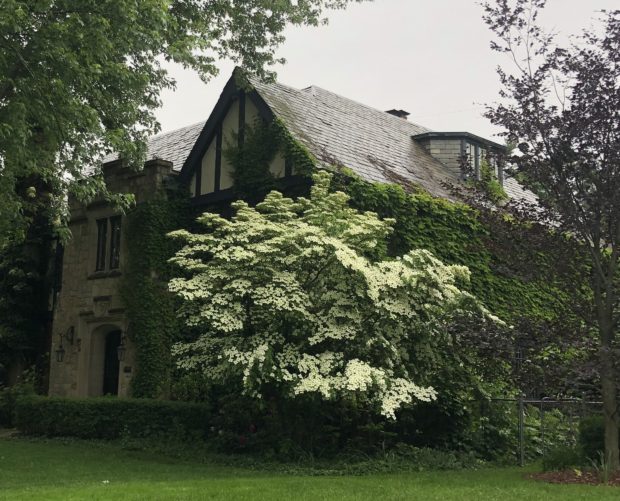 Should you be one of those people who drives the neighborhood to look at holiday lights, a cruise might be in order. You can spot them for at least a block away. Out of flower, they have handsome foliage, and even more handsome exfoliating bark when they are older-but the star of the once in a blue moon show are the flowers.
Should you be one of those people who drives the neighborhood to look at holiday lights, a cruise might be in order. You can spot them for at least a block away. Out of flower, they have handsome foliage, and even more handsome exfoliating bark when they are older-but the star of the once in a blue moon show are the flowers.
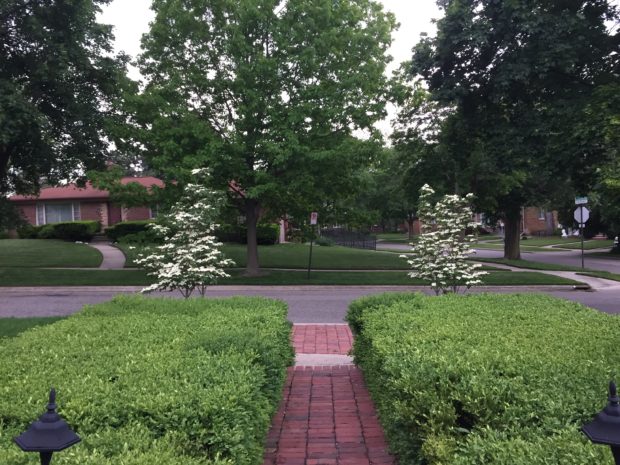 In 2009, a hybrid of Cornus Kousa, and the Pacific coast dogwood, Cornus Nutallii, was introduced from the breeding program at Rutgers University. Again, from the Missouri Botanical Garden website: the dogwood “Venus” These four trees planted in the tree lawn at my house are young, but they will grow. Even at a 2″ caliper size, I can spot the flowers from several blocks away.
In 2009, a hybrid of Cornus Kousa, and the Pacific coast dogwood, Cornus Nutallii, was introduced from the breeding program at Rutgers University. Again, from the Missouri Botanical Garden website: the dogwood “Venus” These four trees planted in the tree lawn at my house are young, but they will grow. Even at a 2″ caliper size, I can spot the flowers from several blocks away.
 This hybrid is hardier than either parent. They thrive in full sun, and grow fast when they are happy. The flowers can easily reach 6″ to 7″ in diameter. We have probably planted better than 100 of them since 2011, with only a few losses. They are a little shy to bloom until they have been in the ground for a year or two, but once they start, they are stop you dead in your tracks gorgeous.
This hybrid is hardier than either parent. They thrive in full sun, and grow fast when they are happy. The flowers can easily reach 6″ to 7″ in diameter. We have probably planted better than 100 of them since 2011, with only a few losses. They are a little shy to bloom until they have been in the ground for a year or two, but once they start, they are stop you dead in your tracks gorgeous.
 They rival the magnolias for the showiest spring flowering tree. As with Cornus Kousa, Venus flowers in June, avoiding late spring frosts that so often damage the flowers of magnolias.
They rival the magnolias for the showiest spring flowering tree. As with Cornus Kousa, Venus flowers in June, avoiding late spring frosts that so often damage the flowers of magnolias.
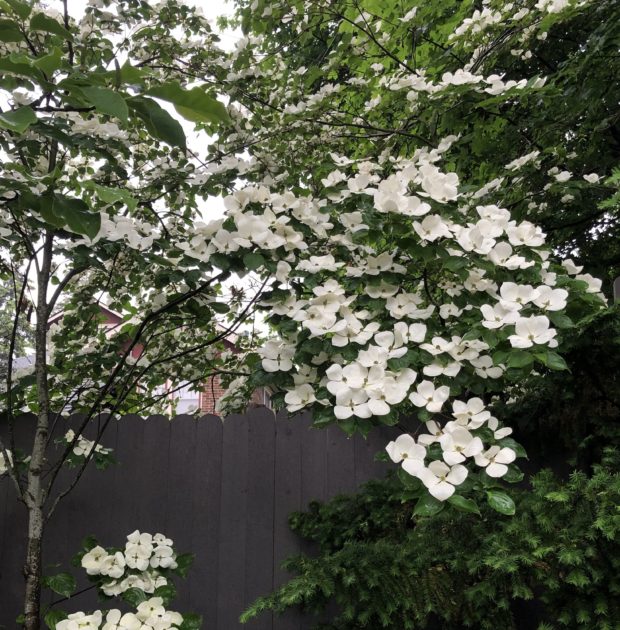 A pair of small trees I planted 3 years ago are covered with flowers this year.
A pair of small trees I planted 3 years ago are covered with flowers this year.
 This shade garden planted some 4 years ago for my clients features a pair of Venus dogwoods. They are especially happy to have them this year.
This shade garden planted some 4 years ago for my clients features a pair of Venus dogwoods. They are especially happy to have them this year.
